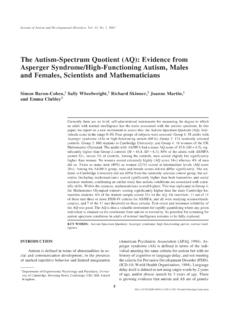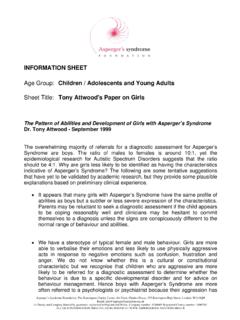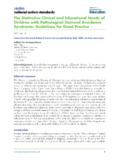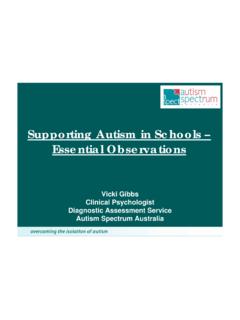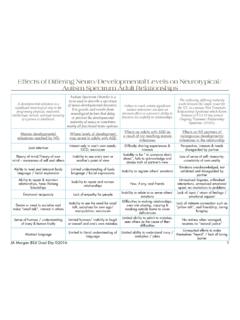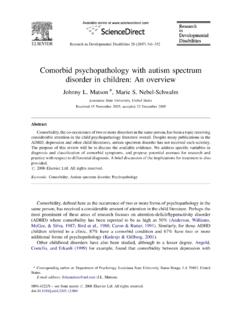Transcription of Cognitive Orientation to (daily) Occupational Performance ...
1 Australian Occupational Therapy Journal (2008)doi: Publishing AsiaResearch ArticleCognitive Orientation to (daily) Occupational Performance (CO-OP) with children with asperger s syndrome who have motor-based Occupational Performance goalsSylvia Rodger and Julia BrandenburgDivision of Occupational Therapy, School of Health and Rehabilitation Sciences, The University of Queensland, Brisbane, Queensland, AustraliaBackground/aim:Motor difficulties associated withAsperger s syndrome (AS) are commonly reported, despitethese not being diagnostically significant. CognitiveOrientation to daily Occupational Performance (CO-OP)is a verbal problem-solving intervention developed for usewith children with developmental coordination disorderto address their motor-based difficulties. This paper reportson two case studies of children with AS illustrating theoutcomes of CO-OP to address motor-based occupationalperformance :A case study approach was used to documenthow two children with AS engaged in 10 weekly sessionsof CO-OP addressing child-chosen motor-based occupationalperformance goals and the outcomes of this :Pre and post-intervention assessment using theCanadian Occupational Performance Measure, VinelandAdaptive Behaviour Scales and the Performance QualityRating Scale indicated that both children were able toengage in CO-OP intervention to successfully improve theiroccupational.
2 Further research into the application ofCO-OP with children with AS is warranted based onpreliminary positive findings regarding the efficacy of thisintervention to address motor-based Performance difficultiesin two children with WORDSA sperger s syndrome , children, cognitiveintervention, motor Performance , Occupational s syndrome (AS) is one of the disorders on theautistic spectrum (ASD) and is characterised by functionaldifficulties in social interaction, communication, and rest-ricted, repetitive behaviours or interests (American Psy-chiatric Association (APA), 2000). In order to fulfil theDSM-IV TR (APA) diagnostic criteria for AS, a child mustdisplay a qualitative impairment in social interaction, forexample, impairment in the use of non-verbal behaviours,failure to develop appropriate peer relationships, lack ofspontaneous attempts to share enjoyment or interests withothers and lack of social or emotional reciprocity.
3 Childrenmust also display restricted, repetitive or stereotypedbehaviours such as preoccupation with restricted patternsof interest, inflexible adherence to non-functional routinesor rituals, stereotyped and repetitive motor mannerismsor persistent preoccupation with parts of objects. Thesedisturbances must cause clinically significant impairmentsin social, Occupational or other areas of functioning (APA).Motor function in asperger s syndromeIn addition to the characteristics included as diagnosticcriteria, AS is commonly associated with motor clumsiness,however, these deficits are not considered diagnosticallysignificant (Attwood, 1998; Smith, 2004). Motor difficul-ties in AS have been widely reported with some studiesindicating the prevalence of such difficulties as exceed-ing 80% (Ghaziuddin, Tsai & Ghaziuddin, 1994; Miyaharaet al., 1997). Difficulties with specific aspects of motorfunction have been reported as well as general clumsi-ness associated with poor motor planning, coordinationand fine motor difficulties (Attwood; Green et al.)
4 , 2003).It has been reported that some children with AS displaysufficient motor difficulties to meet criteria for disordersof motor function according to the DSM-IV (Jansiewiczet al., 2006).Sylvia Rodger , M. Ed. St., PhD; AssociateProfessor and Head. Julia Brandenburg (Hons);Honours : Sylvia Rodger, Division of OccupationalTherapy, School of Health and Rehabilitation Sciences,The University of Queensland, Brisbane, Qld 4072, : for publication 18 November 2007. 2008 The Authors Journal compilation 2008 Australian Association ofOccupational Therapists2S. RODGER AND J. BRANDENBURG 2008 The AuthorsJournal compilation 2008 Australian Association of Occupational TherapistsA study conducted by Green et al. (2003) comparedmotor function in children with AS to that of a matchedgroup of children with Developmental Disorder of MotorFunction using the Movement Assessment Battery forChildren (Henderson & Sugden, 1992).
5 Results of thestudy found that all 11 children in the AS group metthe criteria for a diagnosis of motor impairment with thechildren with AS having a slightly higher mean motorimpairment score than the comparison group of ninechildren with developmental disorder of motor results are consistent with the suggestion of a highprevalence of motor impairment in AS, however, theseneed to be viewed with caution because of the smallsample sizes in each children with AS display an unevenness intheir development of motor skills and achievement ofdevelopmental milestones, however, considerable varia-bility exists and therefore there are no particular motordifficulties that are universal or specific to AS (Baranek,2002; Miller & Ozonoff, 2000; Stone, Ousley, Hepburn,Hogan & Brown, 1999). According to Baranek manychildren with AS also have significant difficulty general-ising newly learned skills to other contexts or applyingcomponent motor skills to functional tasks.
6 It is thereforeessential that interventions not only target specific motorskills, but also provide opportunities for these to bepractised within an ecologically valid context in order tofacilitate transfer of for children with asperger s syndromeMany children with AS experience motor difficulties thatimpact on their functional abilities in a variety of literature to date has focussed on comparing motorskills of children from across the autistic spectrum withchildren diagnosed with other conditions. Comparativelylittle research has been conducted into the effectivenessof interventions to improve motor skills (Rodger & Ziviani,in press). Interventions for children with ASD, whichincludes AS, can be broadly divided into: (i) psychody-namic treatment that is seldom used today as it is nowwell recognised that ASD is a developmental rather thanemotional disorder; (ii) biological treatments, such asmedication, vitamin and dietary supplements, and exclu-sion diets; (iii) educational/behavioural interventions;(iv) communication therapies; (v) sensory motor therapies;and (vi) combined approaches (Roberts, 2004).
7 Inter-ventions commonly used with children with AS includebehavioural modification, social skills training, parenteducation and interventions to address school andeducational needs (Sofronoff, Leslie & Brown, 2004). Occupational therapists often use motor and sensorystrategies to assist children with AS to perform activitiesand enhance their participation. Sensory motor treatmentsfocus on the underlying sensory hypo or hypersensitivitiesseen in children with autism and their difficulties withsensory modulation so that they can maintain optimalarousal and focussed attention. Sensory Integration (SI)(Ayres, 1979) is one approach used by some occupationaltherapists to address these issues. Dawson and Watling(2000) reviewed the evidence on SI, traditional occupationaltherapy and auditory integration training and found poorquality and at best equivocal support for these inter-ventions.
8 Given the limited evidence for some of theseapproaches, better motor outcomes may be achievedthrough interventions that enable the child to performtasks or through modification of the environment(Case-Smith, 2001). Given the variation that exists in thepresentation and severity of AS, it is essential that inter-vention is highly individualised (Klin & Volkmar, 2000).In summary, motor difficulties experienced by childrenwith AS are widely reported in the literature, however,there is relatively little exploration of or evidence forspecific intervention techniques. Motor difficulties arenot a problem exclusive to AS and significant researchinto the effectiveness of intervention strategies for othermotor conditions such as Developmental CoordinationDisorder (DCD) has been conducted. One interventionthat has been used to address such motor difficulties isCognitive Orientation to (daily) Occupational Perform-ance (CO-OP) (Polatajko & Mandich, 2004).
9 Cognitive Orientation to Occupational Performance (CO-OP)CO-OP is a task-orientated problem-solving approachwhich utilises Cognitive skills to improve occupationalperformance. It is a verbally based approach, focussingon teaching children to use self-talk and problem-solvingto address Performance problems (Missiuna, Mandich,Polatajko & Malloy-Miller, 2001). CO-OP is highly indi-vidualised and involves moving from therapist verbalguidance to internal self-dialogue and finally to independentapplication of problem-solving strategies (Polatajko &Mandich, 2004). The three main objectives addressed byCO-OP are skill acquisition in child-chosen tasks, devel-opment of Cognitive strategies, and the generalisation andtransfer of learned skills and strategies (Missiuna et al.).Children are taught a global Cognitive strategy and areguided in the process of discovering other specific cogni-tive strategies relevant to their chosen goals (Polatajko &Mandich, 2004).
10 The global strategy used in CO-OP is the goal, plan, do, check strategy that involves identifyingwhat needs to be done, planning how to achieve this,carrying out the plan and then evaluating its effectiveness(Polatajko, Mandich, Miller & Macnab, 2001). Domainspecific strategies (DSS) are specific Cognitive strategiesthat are task, child or situation specific and focus onfacilitating or improving Performance (Missiuna et al.,2001). The child is guided to develop his/her own strate-gies based on the problems encountered during tasks(Polatajko et al., 2001).CO-OP was developed by Polatajko and colleagues inthe early 1990s to assist children with DCD to achievetheir motor goals. Subsequent studies have provided strongCO-OP AND asperger S SYNDROME3 2008 The AuthorsJournal compilation 2008 Australian Association of Occupational Therapistsconvergent evidence that CO-OP is an effective approachfor use with children with DCD ( Miller, Polatajko,Missiuna, Mandich & Macnab, 2001; Polatajko et al.)
